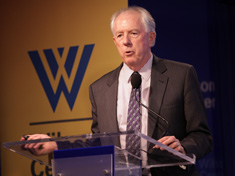-
Banning Garrett: Getting Urbanization Right Can “Solve a Lot of Big Problems”
May 8, 2015 By Carley Chavara
The world is changing quickly thanks to a convergence of megatrends, says Singularity University’s Banning Garrett in this week’s podcast, but urbanization could be the most critical. “If we get it right in cities, we can solve a lot of big problems,” he says.
The world is changing quickly thanks to a convergence of megatrends, says Singularity University’s Banning Garrett in this week’s podcast, but urbanization could be the most critical. “If we get it right in cities, we can solve a lot of big problems,” he says.
“Virtually all population growth will be in cities,” says Garrett. As early as 2050, 70 percent of the world’s estimated 9.6 billion people will live in urban areas, equivalent to 100 more Jakartas in the world. Sustaining these populations will be difficult. “There are about 1 billion people in slums today. It could be 2 billion by 2030,” he says.
However, cities can play an essential role in sustainable development. “The great thing about cities is that everybody is there,” says Garrett. Concentrations of people living together allows for economies of scale and better efficiency in the delivery of goods and services. Garrett cites a study that found GDP per capita increases disproportionately as cities expand, while relative resource use declines. “Cities can be far more efficient as well as more productive,” he says.
Agents of Innovation
Cities are also creating new markets of their own. “Smart city” technologies have attracted new investment in transportation, health care, and communications, and the arrow appears to be pointing up. “It’s going to be a humongous market,” says Garrett, “we’re talking $90 trillion in infrastructure.” Other technologies such as vertical farming and 3-D printing could mean goods are produced at the point of consumption within cities, rather than shipped from afar, reducing transportation and production costs while minimizing carbon footprint.
“Cities have long outlived states…they will still be there when the particular state may be long gone”Gearing a city’s infrastructure for the future is crucial given the staying power of these investments. Garrett pointed out that a coal-fired power plant built in 1949 outside Alexandria, Virginia, was in operation until three years ago, burning an estimated 88 million tons of coal and emitting 233 million tons of carbon dioxide over its 63-year lifetime.
“Cities have long outlived states,” says Garrett, “they will still be there when the particular state may be long gone.” While some national governments are “paralyzed,” Garrett says urban areas have been serving as laboratories for new ways to organize society and use advanced technologies. Mayors now play a role as global actors in their own right. Thousands of city delegations travel the globe sharing best practices and promoting city-to-city learning.
“Cities are where this game is going to play out,” he says, “where governance is either going to take place, or not, and where good governance is going to have to contain this sustainability that we’ve all been talking about.”
“You’ve got to look long term….where would we like to go and what decisions do we have to make to get there?”’
Banning Garrett spoke at the Wilson Center on April 22.
Friday Podcasts are also available for download on iTunes.
Topics: consumption, development, economics, energy, environment, Friday Podcasts, podcast, population, risk and resilience, SDGs, U.S., urbanization
 A Publication of the Stimson Center.
A Publication of the Stimson Center.







